IKEv2 from Android strongSwan to Cisco IOS with EAP and RSA Authentication
Available Languages
Contents
Introduction
This document describes how to configure the mobile version of strongSwan in order to access a Cisco IOS® software VPN gateway via the Internet Key Exchange Version 2 (IKEv2) protocol.
Three examples are presented:
- Android phone with strongSwan that connects to the Cisco IOS software VPN gateway with Extensible Authentication Protocol - Message Digest 5 (EAP-MD5) authentication.
- Android phone with strongSwan that connects to the Cisco IOS software VPN gateway with certificate authentication (RSA).
- Android phone with strongSwan that connects to the Cisco IOS software VPN gateway behind Network Address Translation (NAT). There is a requirement to have two x509 extensions Subject Alternative Name in the VPN gateway certificate.
Cisco IOS software and strongSwan limitations are also included.
Prerequisites
Requirements
Cisco recommends that you have knowledge of these topics:
- Basic knowledge of OpenSSL configuration
- Basic knowledge of Cisco IOS software command-line interface (CLI) configuration
- Basic knowledge of IKEv2
Components Used
The information in this document is based on these software and hardware versions:
- Android 4.0 or later with strongSwan
- Cisco IOS Software Release 15.3T or later
- Cisco Identity Services Engine (ISE) Software, Version 1.1.4 and later
The information in this document was created from the devices in a specific lab environment. All of the devices used in this document started with a cleared (default) configuration. If your network is live, make sure that you understand the potential impact of any command.
Configure
Network Diagram
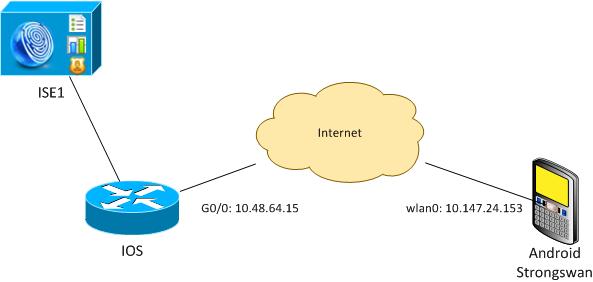
Android strongSwan establishes an IKEv2 tunnel with a Cisco IOS software gateway in order to access internal networks securely.
Certificate Enrollment
Certificates are a prerequisite for both EAP-based and RSA-based authentication.
In the EAP authentication scenario, a certificate is needed only on the VPN gateway. The client connects to the Cisco IOS software only when the software presents a certificate signed by a Certificate Authority (CA) that is trusted on Android. An EAP session then starts for the client to authenticate to the Cisco IOS software.
For RSA-based authentication, both endpoints must have a correct certificate.
When an IP address is used as a peer-ID, there are additional requirements for the certificate. Android strongSwan verifies if the IP address of the VPN gateway is included in the x509 extension Subject Alternative Name. If not, Android drops the connection; this is a good practice as well as a recommendation of RFC 6125.
OpenSSL is used as a CA because the Cisco IOS software has a limitation: it cannot generate certificates with an extension that includes an IP address. All certificates are generated by OpenSSL and imported to Android and the Cisco IOS software.
In the Cisco IOS software, the subject-alt-name command can be used in order to create an extension that includes an IP address, but the command works only with self-signed certificates. Cisco Bug ID CSCui44783, "IOS ENH PKI ability to generate CSR with subject-alt-name extension," is an enhancement request to allow the Cisco IOS software to generate the extension for all types of enrollments.
This is an example of the commands that generate a CA:
#generate key
openssl genrsa -des3 -out ca.key 2048
#generate CSR
openssl req -new -key ca.key -out ca.csr
#remove protection
cp ca.key ca.key.org
openssl rsa -in ca.key.org -out ca.key
#self sign certificate
openssl x509 -req -days 365 -in ca.csr -signkey ca.key -out ca.crt
-extensions v3_req -extfile conf_global.crt
conf_global.crt is a configuration file. The CA extension should be set to TRUE:
[ req ]
default_bits = 1024 # Size of keys
default_md = md5 # message digest algorithm
string_mask = nombstr # permitted characters
#string_mask = pkix # permitted characters
distinguished_name = req_distinguished_name
req_extensions = v3_req
[ v3_req ]
basicConstraints = CA:TRUE
subjectKeyIdentifier = hash
The commands that generate a certificate are very similar for Cisco IOS software and Android. This example assumes that there is already a CA used to sign the certificate:
#generate key
openssl genrsa -des3 -out server.key 2048
#generate CSR
openssl req -new -key server.key -out server.csr
#remove protection
cp server.key server.key.org
openssl rsa -in server.key.org -out server.key
#sign the cert and add Alternate Subject Name extension from
conf_global_cert.crt file with configuration
openssl x509 -req -in server.csr -CA ca.crt -CAkey ca.key -CAcreateserial
-out server.crt -days 365 -extensions v3_req -extfile conf_global_cert.crt
#create pfx file containig CA cert and server cert
openssl pkcs12 -export -out server.pfx -inkey server.key -in server.crt
-certfile ca.crt
conf_global_cert.crt is a configuration file. The Alternate Subject Name extension is a key setting. In this example, the CA extension is set to FALSE:
[ req ]
default_bits = 1024 # Size of keys
default_md = md5 # message digest algorithm
string_mask = nombstr # permitted characters
#string_mask = pkix # permitted characters
distinguished_name = req_distinguished_name
req_extensions = v3_req
[ v3_req ]
basicConstraints = CA:FALSE
subjectKeyIdentifier = hash
subjectAltName = @alt_names
[alt_names]
IP.1 = 10.48.64.15
A certificate should be generated for both the Cisco IOS software and Android.
The IP address 10.48.64.15 belongs to the Cisco IOS software gateway. When you generate a certificate for the Cisco IOS software, make sure the subjectAltName is set to 10.48.64.15. Android validates the certificate received from Cisco IOS software and tries to find its IP address in the subjectAltName.
Cisco IOS Software
The Cisco IOS software needs to have a correct certificate installed for both RSA-based and EAP-based authentication.
The pfx file (which is a pkcs12 container) for the Cisco IOS software can be imported:
BSAN-2900-1(config)# crypto pki import TP pkcs12
http://10.10.10.1/server.pfx password 123456
% Importing pkcs12...
Source filename [server.pfx]?
CRYPTO_PKI: Imported PKCS12 file successfully.
Use the show crypto pki certificates verbose command in order to verify that the import succeeded:
BSAN-2900-1# show crypto pki certificates verbose
Certificate
Status: Available
Version: 3
Certificate Serial Number (hex): 00A003C5DCDEFA146C
Certificate Usage: General Purpose
Issuer:
cn=Cisco
ou=Cisco TAC
o=Cisco
l=Krakow
st=Malopolskie
c=PL
Subject:
Name: IOS
IP Address: 10.48.64.15
cn=IOS
ou=TAC
o=Cisco
l=Krakow
st=Malopolska
c=PL
Validity Date:
start date: 18:04:09 UTC Aug 1 2013
end date: 18:04:09 UTC Aug 1 2014
Subject Key Info:
Public Key Algorithm: rsaEncryption
RSA Public Key: (2048 bit)
Signature Algorithm: SHA1 with RSA Encryption
Fingerprint MD5: 2C45BF10 0BACB98D 444F5804 1DC27ECF
Fingerprint SHA1: 26B66A66 DF5E7D6F 498DD653 A2C164D7 4C7A7F8F
X509v3 extensions:
X509v3 Subject Key ID: AD598A9B 8AB6893B AB3CB8B9 28B2039C 78441E72
X509v3 Basic Constraints:
CA: FALSE
X509v3 Subject Alternative Name:
10.48.64.15
Authority Info Access:
Associated Trustpoints: TP
Storage: nvram:Cisco#146C.cer
Key Label: TP
Key storage device: private config
CA Certificate
Status: Available
Version: 3
Certificate Serial Number (hex): 00DC8EAD98723DF56A
Certificate Usage: General Purpose
Issuer:
cn=Cisco
ou=Cisco TAC
o=Cisco
l=Krakow
st=Malopolskie
c=PL
Subject:
cn=Cisco
ou=Cisco TAC
o=Cisco
l=Krakow
st=Malopolskie
c=PL
Validity Date:
start date: 16:39:55 UTC Jul 23 2013
end date: 16:39:55 UTC Jul 23 2014
Subject Key Info:
Public Key Algorithm: rsaEncryption
RSA Public Key: (2048 bit)
Signature Algorithm: SHA1 with RSA Encryption
Fingerprint MD5: 0A2432DC 33F0DC46 AAB23E26 ED474B7E
Fingerprint SHA1: A50E3892 ED5C4542 FA7FF584 DE07B6E0 654A62D0
X509v3 extensions:
X509v3 Subject Key ID: 786F263C 0F5A1963 D6AD18F8 86DCE7C9 0185911E
X509v3 Basic Constraints:
CA: TRUE
Authority Info Access:
Associated Trustpoints: TP
Storage: nvram:Cisco#F56ACA.cer
BSAN-2900-1#show ip int brief
Interface IP-Address OK? Method Status Protocol
GigabitEthernet0/0 10.48.64.15 YES NVRAM up up
Android
For EAP-based authentication, Andorid needs to have just the correct CA certificate installed.
For RSA-based authentication, Andorid needs to have both the CA certificate and its own certificate installed.
This procedure describes how to install both certificates:
- Send the pfx file by email, and open it.
- Provide the password that was used when the pfx file was generated.
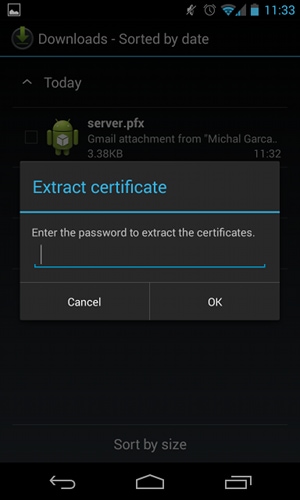
- Provide the name for the imported certificate.
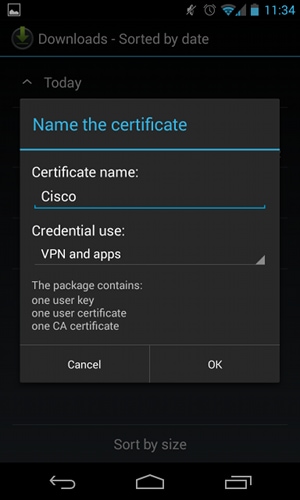
- Navigate to Settings > Security > Trusted Credentials in order to verify the certificate installation. The new certificate should appear in the user store:
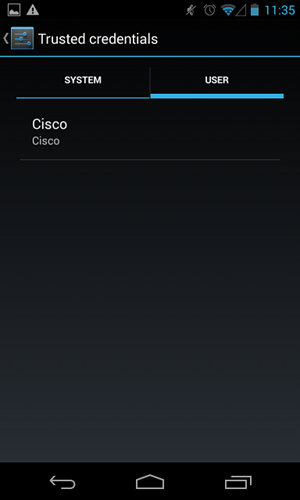
At this point, a user certificate as well as a CA certificate are installed. The pfx file is a pkcs12 container with both the user certificate and the CA certificate.
Android has precise requirements when certificates are imported. For example, for a CA certificate to be imported successfully, Android requires that the x509v3 extension Basic Constraint CA be set to TRUE. Thus, when you generate a CA or use your own CA, it is important to verify that it has the correct extension:
pluton custom_ca # openssl x509 -in ca.crt -text
Certificate:
Data:
Version: 3 (0x2)
Serial Number:
dc:8e:ad:98:72:3d:f5:6a
Signature Algorithm: sha1WithRSAEncryption
Issuer: C=PL, ST=Malopolskie, L=Krakow, O=Cisco, OU=Cisco TAC, CN=Cisco
<.....output omitted>
X509v3 Basic Constraints:
CA:TRUE
<.....output omitted>
EAP Authentication
Cisco IOS Software Configuration for EAP Authentication
IKEv2 allows the use of an EAP protocol stack in order to perform user authentication. The VPN gateway presents itself with the certificate. Once the client trusts that certificate, the client responds to the EAP request identity from the gateway. The Cisco IOS software uses that identity and sends a Radius-Request message to the authentication, authorization, and accounting (AAA) server, and an EAP-MD5 session is established between the supplicant (Android) and the authentication server (Access Control Server [ACS] or ISE).
After successful EAP-MD5 authentication, as indicated by a Radius-Accept message, the Cisco IOS software uses the configuration mode in order to push the IP address to the client and continue with traffic selector negotiation.
Notice that Android has sent IKEID=cisco (as configured). This IKEID received on the Cisco IOS software matches 'ikev2 profile PROF'.
aaa new-model
aaa authentication login eap-list-radius group radius
aaa authorization network IKE2_AUTHOR_LOCAL local
crypto pki trustpoint TP
revocation-check none
crypto ikev2 authorization policy IKE2_AUTHOR_POLICY
pool POOL
!
crypto ikev2 proposal ikev2-proposal
encryption aes-cbc-128
integrity sha1
group 14
!
crypto ikev2 policy ikev2-policy
proposal ikev2-proposal
!
!
crypto ikev2 profile PROF
match identity remote key-id cisco
authentication remote eap query-identity
authentication local rsa-sig
pki trustpoint TP
aaa authentication eap eap-list-radius
aaa authorization group eap list IKE2_AUTHOR_LOCAL IKE2_AUTHOR_POLICY
aaa authorization user eap cached
virtual-template 1
crypto ipsec transform-set 3DES-MD5 esp-aes esp-sha-hmac
mode tunnel
!
crypto ipsec profile PROF
set transform-set 3DES-MD5
set ikev2-profile PROF
interface GigabitEthernet0/0
ip address 10.48.64.15 255.255.255.128
interface Virtual-Template1 type tunnel
ip unnumbered GigabitEthernet0/0
tunnel mode ipsec ipv4
tunnel protection ipsec profile PROF
ip local pool POOL 192.168.0.1 192.168.0.10
radius-server host 10.48.66.185 key cisco
Android Configuration for EAP Authentication
Android strongSwan must have EAP configured:
- Disable automatic certificate selection; otherwise, 100 or more CERT_REQs are sent in the third packet.
- Choose a specific certificate (CA) that was imported in the previous step; the username and password should be the same as on the AAA server.
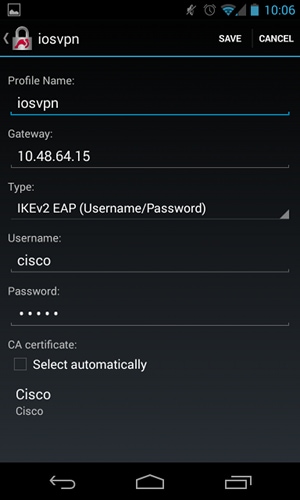
EAP Authentication Test
In the Cisco IOS software, these are the most important debugs for EAP authentication. Most output has been omitted for clarity:
debug crypto ikev2 error
debug crypto ikev2 internal
debug radius authentication
debug radius verbose
IKEv2:New ikev2 sa request admitted
IKEv2:(SA ID = 1):Searching policy based on peer's identity 'cisco' of type
'FQDN'
IKEv2:(1): Choosing IKE profile PROF
IKEv2:Sending certificates as X509 certificates
RADIUS(00000025): Send Access-Request to 10.48.66.185:1645 id 1645/4,len 110
RADIUS: Received from id 1645/4 10.48.66.185:1645, Access-Challenge, len 79
RADIUS(00000025): Send Access-Request to 10.48.66.185:1645 id 1645/5,len 141
RADIUS: Received from id 1645/5 10.48.66.185:1645, Access-Challenge, len 100
RADIUS(00000025): Send Access-Request to 10.48.66.185:1645 id 1645/6,len 155
RADIUS: Received from id 1645/6 10.48.66.185:1645, Access-Accept, len 76
IKEv2:(SA ID = 1):SM Trace-> SA: I_SPI=AABAB198FACAAEDE R_SPI=D61F37C4DC875001
(R) MsgID = 00000004 CurState: R_PROC_EAP_RESP Event: EV_RECV_EAP_SUCCESS
IKEv2:IKEv2 local AAA author request for 'IKE2_AUTHOR_POLICY'
IKEv2:Received group author attributes: ipv4-pool: POOL, route-accept any tag:1
distance:1
IKEv2:Allocated addr 192.168.0.2 from local pool POOL
IKEv2:(SA ID = 1):SM Trace-> SA: I_SPI=AABAB198FACAAEDE R_SPI=D61F37C4DC875001
(R) MsgID = 00000005 CurState: R_VERIFY_AUTH Event:
EV_OK_RECD_VERIFY_IPSEC_POLICY
%LINEPROTO-5-UPDOWN: Line protocol on Interface Virtual-Access1, changed state
to up
The Android logs indicate:
00[DMN] Starting IKE charon daemon (strongSwan 5.1.0dr2,
Linux 3.4.0-perf-gf43c3d9, armv7l)
00[KNL] kernel-netlink plugin might require CAP_NET_ADMIN capability
00[LIB] loaded plugins: androidbridge charon android-log openssl fips-prf
random nonce pubkey pkcs1 pkcs8 pem xcbc hmac socket-default kernel-netlink
00[LIB] unable to load 9 plugin features (9 due to unmet dependencies)
00[JOB] spawning 16 worker threads
13[IKE] initiating IKE_SA android[1] to 10.48.64.15
13[ENC] generating IKE_SA_INIT request 0 [ SA KE No N(NATD_S_IP) N(NATD_D_IP) ]
13[NET] sending packet: from 10.147.24.153[45581] to 10.48.64.15[500]
(648 bytes)
11[NET] received packet: from 10.48.64.15[500] to 10.147.24.153[45581]
(497 bytes)
11[ENC] parsed IKE_SA_INIT response 0 [ SA KE No V V N(NATD_S_IP) N(NATD_D_IP)
CERTREQ N(HTTP_CERT_LOOK) ]
11[ENC] received unknown vendor ID:
43:49:53:43:4f:2d:44:45:4c:45:54:45:2d:52:45:41:53:4f:4e
11[ENC] received unknown vendor ID:
46:4c:45:58:56:50:4e:2d:53:55:50:50:4f:52:54:45:44
11[IKE] faking NAT situation to enforce UDP encapsulation
11[IKE] cert payload ANY not supported - ignored
11[IKE] sending cert request for "C=PL, ST=Malopolskie, L=Krakow, O=Cisco,
OU=Cisco TAC, CN=Cisco"
11[IKE] establishing CHILD_SA android
11[ENC] generating IKE_AUTH request 1 [ IDi N(INIT_CONTACT) CERTREQ
CP(ADDR ADDR6 DNS DNS6) N(ESP_TFC_PAD_N) SA TSi TSr N(MOBIKE_SUP)
11[NET] sending packet: from 10.147.24.153[35564] to 10.48.64.15[4500]
(508 bytes)
10[NET] received packet: from 10.48.64.15[4500] to 10.147.24.153[35564]
(1292 bytes)
10[ENC] parsed IKE_AUTH response 1 [ V IDr CERT AUTH EAP/REQ/ID ]
10[IKE] received end entity cert "C=PL, ST=Malopolska, L=Krakow, O=Cisco,
OU=TAC, CN=IOS"
10[CFG] using certificate "C=PL, ST=Malopolska, L=Krakow, O=Cisco, OU=TAC,
CN=IOS"
10[CFG] using trusted ca certificate "C=PL, ST=Malopolskie, L=Krakow, O=Cisco,
OU=Cisco TAC, CN=Cisco"
10[CFG] reached self-signed root ca with a path length of 0
10[IKE] authentication of '10.48.64.15' with RSA signature successful
10[IKE] server requested EAP_IDENTITY (id 0x3B), sending 'cisco'
10[ENC] generating IKE_AUTH request 2 [ EAP/RES/ID ]
10[NET] sending packet: from 10.147.24.153[35564] to 10.48.64.15[4500]
(76 bytes)
09[NET] received packet: from 10.48.64.15[4500] to 10.147.24.153[35564]
(76 bytes)
09[ENC] parsed IKE_AUTH response 2 [ EAP/REQ/TLS ]
09[IKE] server requested EAP_TLS authentication (id 0x59)
09[IKE] EAP method not supported, sending EAP_NAK
09[ENC] generating IKE_AUTH request 3 [ EAP/RES/NAK ]
09[NET] sending packet: from 10.147.24.153[35564] to 10.48.64.15[4500]
(76 bytes)
08[NET] received packet: from 10.48.64.15[4500] to 10.147.24.153[35564]
(92 bytes)
08[ENC] parsed IKE_AUTH response 3 [ EAP/REQ/MD5 ]
08[IKE] server requested EAP_MD5 authentication (id 0x5A)
08[ENC] generating IKE_AUTH request 4 [ EAP/RES/MD5 ]
08[NET] sending packet: from 10.147.24.153[35564] to 10.48.64.15[4500]
(92 bytes)
07[NET] received packet: from 10.48.64.15[4500] to 10.147.24.153[35564]
(76 bytes)
07[ENC] parsed IKE_AUTH response 4 [ EAP/SUCC ]
07[IKE] EAP method EAP_MD5 succeeded, no MSK established
07[IKE] authentication of 'cisco' (myself) with EAP
07[ENC] generating IKE_AUTH request 5 [ AUTH ]
07[NET] sending packet: from 10.147.24.153[35564] to 10.48.64.15[4500]
(92 bytes)
06[NET] received packet: from 10.48.64.15[4500] to 10.147.24.153[35564]
(236 bytes)
06[ENC] parsed IKE_AUTH response 5 [ AUTH CP(ADDR) SA TSi TSr N(SET_WINSIZE)
N(ESP_TFC_PAD_N) N(NON_FIRST_FRAG) ]
06[IKE] authentication of '10.48.64.15' with EAP successful
06[IKE] IKE_SA android[1] established between
10.147.24.153[cisco]...10.48.64.15[10.48.64.15]
06[IKE] scheduling rekeying in 35421s
06[IKE] maximum IKE_SA lifetime 36021s
06[IKE] installing new virtual IP 192.168.0.1
06[IKE] received ESP_TFC_PADDING_NOT_SUPPORTED, not using ESPv3 TFC padding
06[IKE] CHILD_SA android{1} established with SPIs c776cb4f_i ea27f072_o and
TS 192.168.0.1/32 === 0.0.0.0/0
06[DMN] setting up TUN device for CHILD_SA android{1}
06[DMN] successfully created TUN device
This example shows how to verify status on the Cisco IOS software:
BSAN-2900-1#show crypto session detail
Crypto session current status
Code: C - IKE Configuration mode, D - Dead Peer Detection
K - Keepalives, N - NAT-traversal, T - cTCP encapsulation
X - IKE Extended Authentication, F - IKE Fragmentation
Interface: Virtual-Access1
Uptime: 00:02:12
Session status: UP-ACTIVE
Peer: 10.147.24.153 port 60511 fvrf: (none) ivrf: (none)
Phase1_id: cisco
Desc: (none)
IKEv2 SA: local 10.48.64.15/4500 remote 10.147.24.153/60511 Active
Capabilities:NX connid:1 lifetime:23:57:48
IPSEC FLOW: permit ip 0.0.0.0/0.0.0.0 host 192.168.0.2
Active SAs: 2, origin: crypto map
Inbound: #pkts dec'ed 40 drop 0 life (KB/Sec) 4351537/3468
Outbound: #pkts enc'ed 5 drop 0 life (KB/Sec) 4351542/3468
BSAN-2900-1#show crypto ikev2 sa detailed
IPv4 Crypto IKEv2 SA
Tunnel-id Local Remote fvrf/ivrf Status
1 10.48.64.15/4500 10.147.24.153/60511 none/none READY
Encr: AES-CBC, keysize: 128, Hash: SHA96, DH Grp:14, Auth sign: RSA,
Auth verify: EAP
Life/Active Time: 86400/137 sec
CE id: 1002, Session-id: 2
Status Description: Negotiation done
Local spi: D61F37C4DC875001 Remote spi: AABAB198FACAAEDE
Local id: 10.48.64.15
Remote id: cisco
Remote EAP id: cisco
Local req msg id: 0 Remote req msg id: 6
Local next msg id: 0 Remote next msg id: 6
Local req queued: 0 Remote req queued: 6
Local window: 5 Remote window: 1
DPD configured for 0 seconds, retry 0
Fragmentation not configured.
Extended Authentication configured.
NAT-T is detected outside
Cisco Trust Security SGT is disabled
Assigned host addr: 192.168.0.2
Initiator of SA : No
These figures show how to verify status on Android:
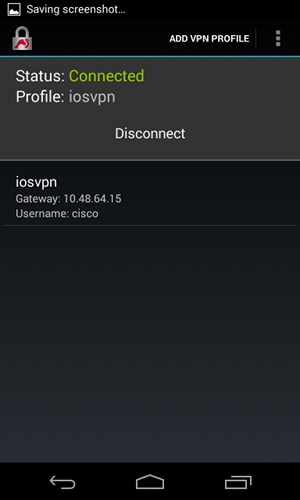
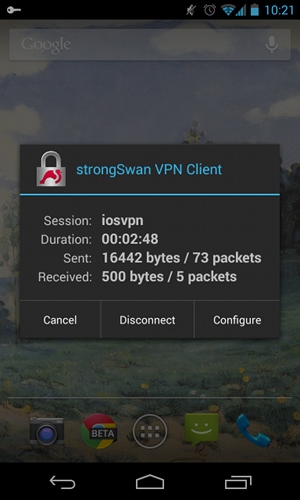
RSA Authentication
Cisco IOS Software Configuration for RSA Authentication
In Rivest-Shamir-Adleman (RSA) authentication, Android sends the certificate in order to authenticate to the Cisco IOS software. That is why the certificate map that binds that traffic to a specific IKEv2 profile is needed. User EAP authentication is not required.
This is an example of how RSA authentication for a remote peer is set:
crypto pki certificate map CERT_MAP 10
subject-name co android
crypto ikev2 profile PROF
match certificate CERT_MAP
authentication remote rsa-sig
authentication local rsa-sig
pki trustpoint TP
aaa authorization group cert list IKE2_AUTHOR_LOCAL IKE2_AUTHOR_POLICY
virtual-template 1
Android Configuration for RSA Authentication
User credentials have been replaced by the user certificate:

RSA Authentication Test
In the Cisco IOS software, these are the most important debugs for RSA authentication. Most output has been omitted for clarity:
debug crypto ikev2 error
debug crypto ikev2 internal
debug crypto pki transactions
debug crypto pki validation
debug crypto pki messages
IKEv2:New ikev2 sa request admitted
IKEv2:(SA ID = 1):Searching policy based on peer's identity 'cn=android,ou=TAC,
o=Cisco,l=Krakow,st=Malopolska,c=PL' of type 'DER ASN1 DN'
IKEv2:(1): Choosing IKE profile PROF
IKEv2:Sending certificates as X509 certificates
IKEv2:(SA ID = 1):Peer's authentication method is 'RSA'
IKEv2:Peer has sent X509 certificates
CRYPTO_PKI: Found a issuer match
CRYPTO_PKI: (9000B) Certificate is verified
CRYPTO_PKI: (9000B) Certificate validation succeeded
IKEv2:(SA ID = 1):[Crypto Engine -> IKEv2] Verification of signed
authentication data PASSED
IKEv2:IKEv2 local AAA author request for 'IKE2_AUTHOR_POLICY'
IKEv2:Received group author attributes: ipv4-pool: POOL, route-accept any tag:1
distance:1
IKEv2:Allocated addr 192.168.0.3 from local pool POOL
IKEv2:(SA ID = 1):SM Trace-> SA: I_SPI=E53A57E359A8437C R_SPI=A03D273FC75EEBD9
(R) MsgID = 00000001 CurState: R_VERIFY_AUTH Event:
EV_OK_RECD_VERIFY_IPSEC_POLICY
%LINEPROTO-5-UPDOWN: Line protocol on Interface Virtual-Access1, changed state
to up
The Android logs indicate:
00[DMN] Starting IKE charon daemon (strongSwan 5.1.0dr2,
Linux 3.4.0-perf-gf43c3d9, armv7l)
00[KNL] kernel-netlink plugin might require CAP_NET_ADMIN capability
00[LIB] loaded plugins: androidbridge charon android-log openssl fips-prf
random nonce pubkey pkcs1 pkcs8 pem xcbc hmac socket-default
00[LIB] unable to load 9 plugin features (9 due to unmet dependencies)
00[JOB] spawning 16 worker threads
05[CFG] loaded user certificate 'C=PL, ST=Malopolska, L=Krakow, O=Cisco,
OU=TAC, CN=android' and private key
05[CFG] loaded CA certificate 'C=PL, ST=Malopolskie, L=Krakow, O=Cisco,
OU=Cisco TAC, CN=Cisco'
05[IKE] initiating IKE_SA android[4] to 10.48.64.15
05[ENC] generating IKE_SA_INIT request 0 [ SA KE No N(NATD_S_IP) N(NATD_D_IP) ]
05[NET] sending packet: from 10.147.24.153[34697] to 10.48.64.15[500]
(648 bytes)
10[NET] received packet: from 10.48.64.15[500] to 10.147.24.153[34697]
(497 bytes)
10[ENC] parsed IKE_SA_INIT response 0 [ SA KE No V V N(NATD_S_IP) N(NATD_D_IP)
CERTREQ N(HTTP_CERT_LOOK) ]
10[ENC] received unknown vendor ID:
43:49:53:43:4f:2d:44:45:4c:45:54:45:2d:52:45:41:53:4f:4e
10[ENC] received unknown vendor ID:
46:4c:45:58:56:50:4e:2d:53:55:50:50:4f:52:54:45:44
10[IKE] faking NAT situation to enforce UDP encapsulation
10[IKE] cert payload ANY not supported - ignored
10[IKE] sending cert request for "C=PL, ST=Malopolskie, L=Krakow, O=Cisco,
OU=Cisco TAC, CN=Cisco"
10[IKE] authentication of 'C=PL, ST=Malopolska, L=Krakow, O=Cisco, OU=TAC,
CN=android' (myself) with RSA signature successful
10[IKE] sending end entity cert "C=PL, ST=Malopolska, L=Krakow, O=Cisco,
OU=TAC, CN=android"
10[IKE] establishing CHILD_SA android
10[ENC] generating IKE_AUTH request 1 [ IDi CERT N(INIT_CONTACT) CERTREQ
AUTH CP(ADDR ADDR6 DNS DNS6) N(ESP_TFC_PAD_N) SA
10[NET] sending packet: from 10.147.24.153[44527] to 10.48.64.15[4500]
(1788 bytes)
12[NET] received packet: from 10.48.64.15[4500] to 10.147.24.153[44527]
(1420 bytes)
12[ENC] parsed IKE_AUTH response 1 [ V IDr CERT AUTH CP(ADDR) SA TSi TSr
N(SET_WINSIZE) N(ESP_TFC_PAD_N) N(NON_FIRST_FRAG)
12[IKE] received end entity cert "C=PL, ST=Malopolska, L=Krakow, O=Cisco,
OU=TAC, CN=IOS"
12[CFG] using certificate "C=PL, ST=Malopolska, L=Krakow, O=Cisco, OU=TAC,
CN=IOS"
12[CFG] using trusted ca certificate "C=PL, ST=Malopolskie, L=Krakow, O=Cisco,
OU=Cisco TAC, CN=Cisco"
12[CFG] reached self-signed root ca with a path length of 0
12[IKE] authentication of '10.48.64.15' with RSA signature successful
12[IKE] IKE_SA android[4] established between 10.147.24.153[C=PL,
ST=Malopolska, L=Krakow, O=Cisco, OU=TAC,
CN=android]...10.48.64.15[10.48.64.15]
12[IKE] scheduling rekeying in 35413s
12[IKE] maximum IKE_SA lifetime 36013s
12[IKE] installing new virtual IP 192.168.0.3
12[IKE] received ESP_TFC_PADDING_NOT_SUPPORTED, not using ESPv3 TFC padding
12[IKE] CHILD_SA android{4} established with SPIs ecb3af87_i b2279175_o and
TS 192.168.0.3/32 === 0.0.0.0/0
12[DMN] setting up TUN device for CHILD_SA android{4}
12[DMN] successfully created TUN device
In the Cisco IOS software, RSA is used for both signing and verification; in the previous scenario, EAP was used for verification:
BSAN-2900-1#show crypto ikev2 sa detailed
IPv4 Crypto IKEv2 SA
Tunnel-id Local Remote fvrf/ivrf Status
1 10.48.64.15/4500 10.147.24.153/44527 none/none READY
Encr: AES-CBC, keysize: 128, Hash: SHA96, DH Grp:14, Auth sign: RSA,
Auth verify: RSA
Life/Active Time: 86400/16 sec
CE id: 1010, Session-id: 3
Status Description: Negotiation done
Local spi: A03D273FC75EEBD9 Remote spi: E53A57E359A8437C
Local id: 10.48.64.15
Remote id: cn=android,ou=TAC,o=Cisco,l=Krakow,st=Malopolska,c=PL
Local req msg id: 0 Remote req msg id: 2
Local next msg id: 0 Remote next msg id: 2
Local req queued: 0 Remote req queued: 2
Local window: 5 Remote window: 1
DPD configured for 0 seconds, retry 0
Fragmentation not configured.
Extended Authentication not configured.
NAT-T is detected outside
Cisco Trust Security SGT is disabled
Assigned host addr: 192.168.0.3
Initiator of SA : No
Status verification on Android is similar to that in the previous scenario.
VPN Gateway Behind NAT - strongSwan and Cisco IOS Software Limitations
This example explains a limitation of strongSwan certificate verifications.
Assume that the Cisco IOS software VPN gateway IP address is statically translated from 172.16.1.1 to 10.147.25.80. EAP authentication is used.
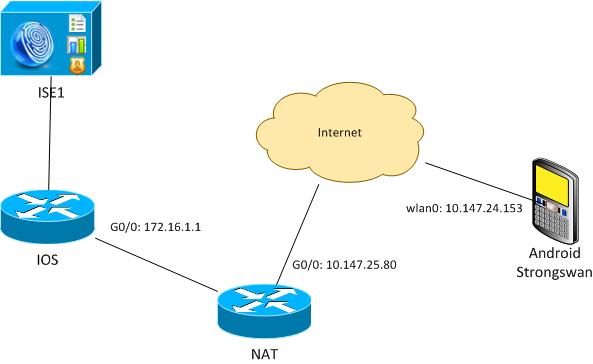
Assume also that the Cisco IOS software certificate has a Subject Alternative Name for both 172.16.1.1 and 10.147.25.80.
After successful EAP authentication, Android performs verification and tries to find the IP address of the peer that was used in Android configuration (10.147.25.80) in the Subject Alternative Name extension. The verification fails:
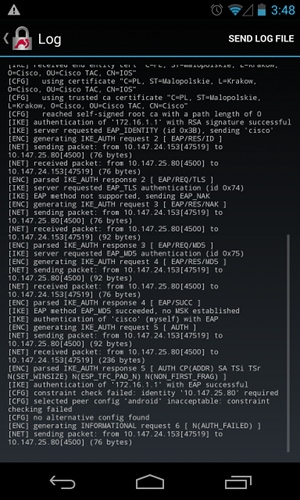
The logs indicate:
constraint check failed: identity '10.147.25.80' required
The failure occurred because Android can read only the first Subject Alternative Name extension (172.16.1.1).
Now, assume that the Cisco IOS software certificate has both addresses in Subject Alternative Name but in the reverse order: 10.147.25.80 and 172.16.1.1. Android performs validation when it receives the IKEID, which is the IP address of VPN gateway (172.16.1.1), in the third packet:
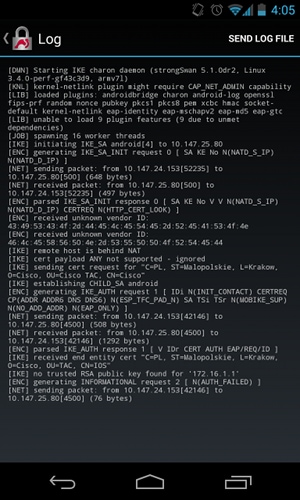
Now the log shows:
no trusted RSA public key found for '172.16.1.1'
Thus, when Android receives the IKEID, it needs to find the IKEID in the Subject Alternative Name and can use only the first IP address.
Verify
Verification and test procedures are available within the configuration examples.
Troubleshoot
This section provides information you can use to troubleshoot your configuration.
strongSwan CA Multiple CERT_REQ
When the certificate setting on strongSwan is Automatic Selection (the default), Android sends CERT_REQ for all trusted certificates in the local store in the third packet . The Cisco IOS software might drop the request because it recognizes a large number of certificate requests as a Denial of Service attack:
*Jul 15 07:54:13: IKEv2:number of cert req exceeds the reasonable limit (100)
Tunnel Source on DVTI
Although it is fairly common to set the tunnel source on a virtual tunnel interface (VTI), it is not necessary here. Assume the tunnel source command is under a dynamic VTI (DVTI):
interface Virtual-Template1 type tunnel
ip unnumbered GigabitEthernet0/0
tunnel source GigabitEthernet0/0
tunnel mode ipsec ipv4
tunnel protection ipsec profile PROF
After authentication, if the Cisco IOS software tries to create virtual access interface that is cloned from a virtual template, it returns an error:
*Aug 1 13:34:22 IKEv2:Allocated addr 192.168.0.9 from local pool POOL
*Aug 1 13:34:22 IKEv2:(SA ID = 1):Set received config mode data
*Aug 1 13:34:22 IKEv2:% DVTI create request sent for profile PROF with PSH
index 1
*Aug 1 13:34:22 IKEv2:Failed to process KMI delete SA message with error 4
*Aug 1 13:34:24 IKEv2:Got a packet from dispatcher
*Aug 1 13:34:24 IKEv2:Processing an item off the pak queue
*Aug 1 13:34:24 IKEv2:Negotiation context locked currently in use
Two seconds after the failure, the Cisco IOS software receives a retransmitted IKE_AUTH from Android. That packet is dropped.
Cisco IOS Software Bugs and Enhancement Requests
- Cisco Bug ID CSCui46418, "IOS Ikev2 ip address sent as identity for RSA authentication."
This bug is not a problem, as long as strongSwan can see a correct Subject Alternative Name (the IP address) when it looks for the IKEID in the certificate in order to perform verification. - Cisco Bug ID CSCui44976, "IOS PKI incorrectly displayed X509v3 extension Subject Alternative Name."
This bug occurs only when there are multiple IP addresses in the Subject Alternative Name. Only the last IP address is displayed, but that does not impact certificate usage. The whole certificate is sent and processed correctly. - Cisco Bug ID CSCui44783, "IOS ENH PKI ability to generate CSR with subject-alt-name extension."
- Cisco Bug ID CSCui44335, "ASA ENH Certificate x509 extensions displayed."
Related Information
Contact Cisco
- Open a Support Case

- (Requires a Cisco Service Contract)




 Feedback
Feedback